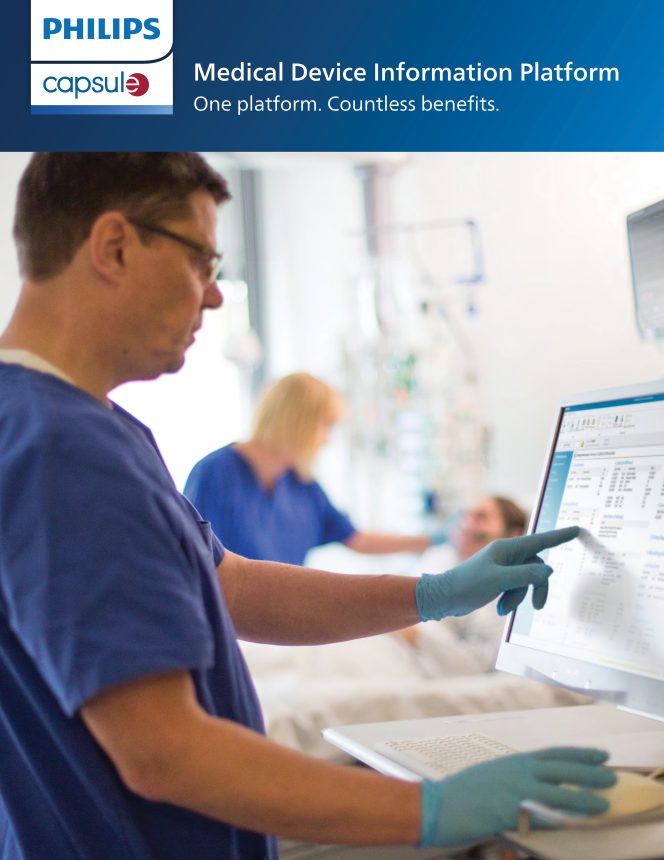It is standard practice for data from patient devices such as monitors and ventilators to be continuously captured in critical care areas. Such connectivity eliminates delays in data entry, decreases clinician workload, and ensures accuracy of data since outputs are collected directly from the source. Clinicians can also access a complete, accurate patient record from connected documentation and clinical information systems to support their decisions, yielding safe, fully informed care and strong interdisciplinary communication.
Integrating devices beyond monitors and ventilators – as well as outside of critical care units – can yield similar operational efficiency, and clinical, communication and patient safety benefits. Furthermore, broader integration would likely increase clinician engagement, considering a survey of nurses found 93% strongly agreed that medical devices should be able to seamlessly share data automatically, while 74% strongly agreed that it is burdensome to manage the data collected by medical devices.
Given these benefits to the hospital, clinicians and patients, devoting the resources to broaden the scope of medical device integration is well worth the investment.
Beyond Ventilators and Monitors
Dialysis is a prime example of how integrating additional devices can improve operational efficiency and support effective clinical decisions in departments other than the ICU. Outside of the ICU or similar environments, hemodialysis data may be manually recorded and later entered into the electronic health record (EHR) and other downstream systems, which could result in an incomplete or inaccurate record. Automatically capturing the data creates comprehensive and accurate documentation in a fraction of the time, enabling clinicians to spend more time with the patient. Since patients receiving hemodialysis also often have multiple comorbidities, a complete record better supports the decisions of the several specialists on the care team.
Another device integration that can save clinician time and protect patient safety is cardiopulmonary bypass machines used during surgery. Although the patient’s vital signs are continuously monitored, the cardiopulmonary bypass machine is not typically integrated. Perfusionists often need to handwrite notes and verbalize the machine-captured data to the operating room team, which increases their burden and raises the risk for misstating or mishearing the information. Instead, when the machine is connected to a medical device integration platform, data can be shared with relevant interdisciplinary care team members, such as the anesthesiology team, so they can view the most recent outputs without an intermediary.
After surgery, integrating data from intra-aortic balloon pump, end-tidal CO2 or pulse oximeter devices, for example, offer clinicians across care teams greater visibility over their patient’s recovery. The resulting, complete documentation can also facilitate efficient communication and consultation between clinicians.
Decreased Alert Fatigue
Patient safety alerts can also be more relevant when devices are connected, and their data is centrally collected and analyzed by a clinical surveillance system. This alleviates clinicians from responding to every audible alert, which can reach as many as 1,000 per shift, contributing to alert fatigue. The term ‘alert fatigue’ describes how busy clinicians become desensitized to safety alerts, and as a result may inadvertently ignore or fail to respond to such warnings, according to the Agency for Healthcare Research and Quality. Fewer nuisance alerts, and more relevant and actionable alerts, can help prevent alert fatigue while improving clinician preparedness and response.
Continuous monitoring of numerous physiologic parameters with more intelligent alerts also enables clinicians to respond before an adverse event occurs. A study of more than 7,800 cardiac patients found nearly 60% had at least one abnormal vital sign one to four hours before cardiac arrest, and more than 13% had at least one severely abnormal vital sign. Broader device data capture can feed a clinical surveillance system to help clinicians intervene before such an event. One such system to monitor post-surgical patients in a non-critical orthopedic unit cut the number of rescue events nearly in half, from 3.4 to 1.2 events per 1,000 patient discharges and reduced transfers to the ICU from 5.6 to 2.9 per 1,000 patient days.
As this study and a growing body of clinical research show, effective data management drives operational, clinical and patient outcome success, whether under traditional or value-based care payment models. This means each data point from a medical device, however and wherever it is captured – ICU, med-surg, outpatient clinic, home or somewhere else – has value if harnessed properly. In this age of healthcare digitization, now is the time to start reaping more of that value for the hospital, providers, and most importantly, patients.
RELATED READING: Adverse Events Can Happen Anywhere, Anytime, Including Patient Transport
An Experienced Partner
To support this medical device integration expansion, Capsule has a library of 1,000 supported devices that can be integrated with the EHR and other downstream systems, such as clinical surveillance applications, through its vendor-agnostic clinical computing hubs. In fact, 80% of the device integrations requested by hospitals and health systems are already supported across more than a dozen device types, including dialysis, anesthesia, intra-aortic balloon pumps, bed gateways, incubators and others.
Device connectivity with the EHR and other downstream systems is only getting started. Capsule can help hospitals and health systems achieve their clinical and financial goals through continuous clinical surveillance, regardless of their patients’ locations. Learn more about our medical device integration solutions.
About the authors
Halley Herndon, RN, is senior clinical consultant; Cathleen Olguin, MBA, BSN, RN, CNOR is senior clinical solutions executive; and Teresa Soman, MBA, PMP is director of product management at Capsule Technologies.
Capsule MDIP anticipates and manages the complexities of medical device integration.
Download